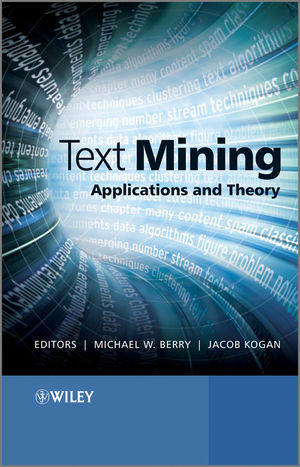Text Mining: Applications and TheoryISBN: 978-0-470-74982-1
Hardcover
222 pages
May 2010
 |
||||||
Preface.
PART I TEXT EXTRACTION, CLASSIFICATION, AND CLUSTERING.
1 Automatic keyword extraction from individual documents.
1.1 Introduction.
1.2 Rapid automatic keyword extraction.
1.3 Benchmark evaluation.
1.4 Stoplist generation.
1.5 Evaluation on news articles.
1.6 Summary.
1.7 Acknowledgements.
2 Algebraic techniques for multilingual document clustering.
2.1 Introduction.
2.2 Background.
2.3 Experimental setup.
2.4 Multilingual LSA.
2.5 Tucker1 method.
2.6 PARAFAC2 method.
2.7 LSA with term alignments.
2.8 Latent morpho-semantic analysis (LMSA).
2.9 LMSA with term alignments.
2.10 Discussion of results and techniques.
2.11 Acknowledgements.
3 Content-based spam email classification using machine-learning algorithms.
3.1 Introduction.
3.2 Machine-learning algorithms.
3.3 Data preprocessing.
3.4 Evaluation of email classification.
3.5 Experiments.
3.6 Characteristics of classifiers.
3.7 Concluding remarks.
3.8 Acknowledgements.
4 Utilizing nonnegative matrix factorization for email classification problems.
4.1 Introduction.
4.2 Background.
4.3 NMF initialization based on feature ranking.
4.4 NMF-based classification methods.
4.5 Conclusions.
4.6 Acknowledgements.
5 Constrained clustering with k-means type algorithms.
5.1 Introduction.
5.2 Notations and classical k-means.
5.3 Constrained k-means with Bregman divergences.
5.4 Constrained smoka type clustering.
5.5 Constrained spherical k-means.
5.6 Numerical experiments.
5.7 Conclusion.
PART II ANOMALY AND TREND DETECTION.
6 Survey of text visualization techniques.
6.1 Visualization in text analysis.
6.2 Tag clouds.
6.3 Authorship and change tracking.
6.4 Data exploration and the search for novel patterns.
6.5 Sentiment tracking.
6.6 Visual analytics and FutureLens.
6.7 Scenario discovery.
6.8 Earlier prototype.
6.9 Features of FutureLens.
6.10 Scenario discovery example: bioterrorism.
6.11 Scenario discovery example: drug trafficking.
6.12 Future work.
7 Adaptive threshold setting for novelty mining.
7.1 Introduction.
7.2 Adaptive threshold setting in novelty mining.
7.3 Experimental study.
7.4 Conclusion.
8 Text mining and cybercrime.
8.1 Introduction.
8.2 Current research in Internet predation and cyberbullying.
8.3 Commercial software for monitoring chat.
8.4 Conclusions and future directions.
8.5 Acknowledgements.
PART III TEXT STREAMS.
9 Events and trends in text streams.
9.1 Introduction.
9.2 Text streams.
9.3 Feature extraction and data reduction.
9.4 Event detection.
9.5 Trend detection.
9.6 Event and trend descriptions.
9.7 Discussion.
9.8 Summary.
9.9 Acknowledgements.
10 Embedding semantics in LDA topic models.
10.1 Introduction.
10.2 Background.
10.3 Latent Dirichlet allocation.
10.4 Embedding external semantics from Wikipedia.
10.5 Data-driven semantic embedding.
10.6 Related work.
10.7 Conclusion and future work.
References.
Index.



